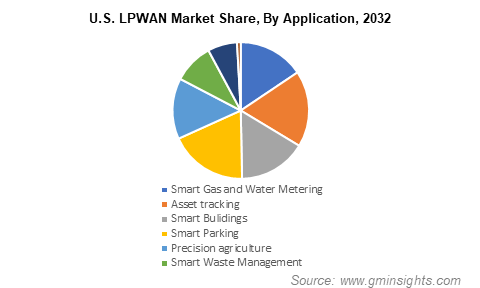Home > Semiconductors & Electronics > Telecom and Networking > Telecom Hardware > Low Power Wide Area Network (LPWAN) Market
Low Power Wide Area Network (LPWAN) Market Analysis
- Report ID: GMI674
- Published Date: Nov 2022
- Report Format: PDF
LPWAN Market Analysis
The low power wide area network market from the platform component segment will register more than 50% growth rate through 2032. An increase in IoT connections across industry verticals, such as utilities, retail, transportation, manufacturing, and healthcare, will stimulate the deployment of LPWAN technologies. These platforms can support connected devices that require long-range, low power consumption, and less costs.
The cloud deployment model will exhibit about 55% gains up to 2032. The need for the simplification of IoT implementation to meet business needs is among the major drivers for cloud-based LPWAN demand. The adoption of LPWAN technologies in such devices further increases the complexity of managing multimodal LPWANs and designing IoT applications. Factors such as these thus support the advancement of cloud-based virtual LPWA networks to efficiently manage multimodal communications.
In terms of the application, the smart parking segment held over 10% of the LPWAN market share in 2022, owing to the efficient management of parking assets through LTE-M and NB-IoT technologies. NB-IoT technology, especially, is gaining momentum in this application as it can support long-battery life and provide wide area coverage.
The low power wide area network market from the agriculture end-use segment is set to depict nearly 55% growth through between 2023 and 2032, due to the increasing adoption of AI and IoT technologies for the efficient management of farming operations. Farmers have been applying these technologies in livestock monitoring, fish farming, vehicle tracking on farms, and fuel storage monitoring. In addition, the increasing reliance on smart agriculture practices and IoT installations will accelerate the use of LoRA and other LPWAN technologies in the agriculture sector.

The Europe LPWAN market size is set to cross USD 80 billion by 2032, given the rapid digital transformation and the popularity of smart manufacturing. Regional governments are also emphasizing the implementation of smart cities equipped with smart traffic control systems, parking systems, buildings, fire detection systems, and water metering. Since these projects are reliant on the use of IoT devices, the steady rise in smart city development efforts across Europe is likely to promote the adoption of LPWAN networks for their long-range and low-power capabilities.

